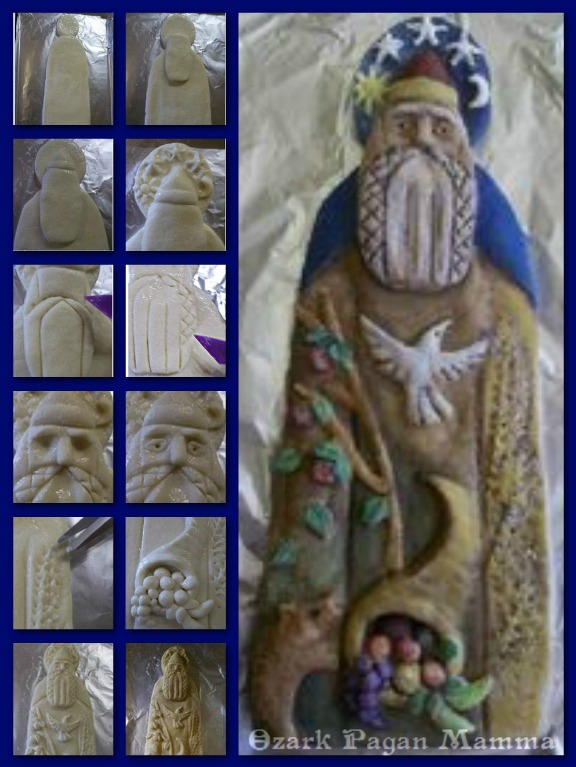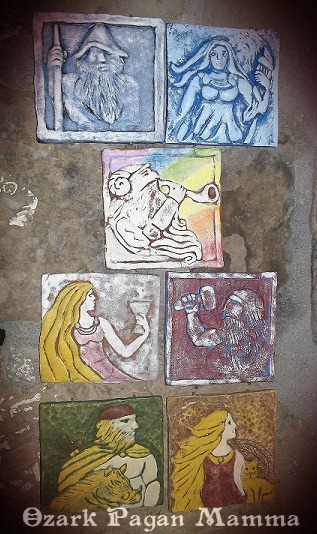Lately I’ve gone through a period of very little personal spiritual practice. I’ve been wanting to get back into using my altars; I have kind of a sprawling altar on the mantle and adjacent shelves in the den, and a compact version in the kitchen. Most days I do a variation of Sigrdrifa’s prayer at my bedroom window in the morning. This seems to be my default setting for bare minimum personal spiritual practice. I have had several kinds of daily devotionals in the past, usually taking the form of ADF-lite, a simple CR ritual, or a blot/hussel. For consistent daily practice, however, none of these forms have staying power for me. Also, though my background is in Norse and Celtic hearth cultures, sometimes I don’t want to be very culturally specific. I am a squishy/soft polytheist after all, and I have embraced (my own version of) Waincraft in recent years.
So after much procrastination, I’ve come up with a new routine. It was important to me to find a spiritual routine that has a non-verbal option. There are several reasons for this:
- While other people are at home, I’d rather not be overheard.
- When I have a spoken daily devotional, I often end up saying the same things every day, to the point of meaninglessness.
- There are many times I just really don’t feel like speaking.
- Also, not feeling obligated to speak frees up my mind for deeper contemplation and also allows me to concentrate a little more on actions.
So concentrating more on actions and contemplation, I’ve come up with this sequence of events in personal daily ritual:
Altar Refreshing and Preparation
Before doing ritual, I make sure the altar surface and items on it are clean, arranged well, and dusted. Then I refresh the water bowl/cauldron. Before replacing it on the altar, I first lift it in reverence to the deity/spirit images.
Water Blessing
I dab some of the water from the water bowl on my forehead and do a clearing/grounding. I then anoint the statues on the altar with the water. If I’m drawn to saying something here, it may be “Water cleanse me.” or “The Waters of Danu flow through all.”.
Fire Blessing
I light the candle on the altar and raise it to each of the statues as I did with the water (when refreshing the altar). I then set the candle back in place, cup my hand above the flame, then touch the same hand to my forehead to receive a fire purification/blessing. Here I might say “May the fire of the gods, hallow.” or “Thunor hallow.”.
Incense (and other) Offerings
I light an incense stick or cone and circle it around each of the statues/images. I say a simple hail to each entity being honored or make a mental connection equivalent to an evocation. Occasionally, I may place other offerings in a bowl on the working surface of the altar, if I’m at the altar in the den. At this point, if I’m not rushed, (and especially if I’m at the altar in the den instead of the kitchen,) I take a little time to meditate, contemplate, and further connect to the deities/spirits/powers.
Omen (optional)
I ask for guidance (mentally or aloud) and draw a rune for the day.
Giving Thanks & Closing
I end this daily devotional with simple words or thoughts of thanks and touching the edge/feet of each statue/image in reverence. When I feel the need, I use my usual words of ending inspired by the Carmina Gadelica: “As it was, as it is, as it evermore shall be, with the ebb, with the flow, blessed be.”.
This may be the simplest daily ritual I have ever adopted that still involved the use of materials and an altar. There’s really nothing to memorize nor ways to goof it up, and though I’ve just begun to use it, the feel of it is timeless. If it inspires you too, feel free to use it.



















